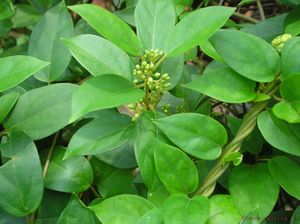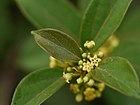Note: This is a project under development. The articles on this wiki are just being initiated and broadly incomplete. You can Help creating new pages.
Gymnema sylvestre - Madhunaashini
Gymnema sylvestre is an herb native to the tropical forests of southern and central India and Sri Lanka. Common names include Gymnema,Cowplant, Australian Cowplant, and Periploca of the woods.
Contents
[hide]- 1 Uses
- 2 Parts Used
- 3 Chemical Composition
- 4 Common names
- 5 Properties
- 6 Habit
- 7 Identification
- 8 List of Ayurvedic medicine in which the herb is used
- 9 Where to get the saplings
- 10 Mode of Propagation
- 11 How to plant/cultivate
- 12 Commonly seen growing in areas
- 13 Photo Gallery
- 14 References
- 15 External Links
Uses
Diabetes, Fever, Cough, Swollen glands, Epilepsy, Boils, Pimples, Diarrhoea, Sore throats[1].
Parts Used
Chemical Composition
Flavones, Anthraquinones, Hentri-acontane, Pentatriacontane, α and β-chlorophylls, Phytin, Resins, D-quercitol, Tartaric acid, Formic acid, Butyric acid, Lupeol, β-amyrin.[2]
Common names
| Language | Common name |
|---|---|
| Kannada | Madhunashini ಮಧುನಾಶಿನಿ |
| Hindi | Gurmar |
| Malayalam | Cakkarakkolli |
| Tamil | Cirukurinca |
| Telugu | Podapatri |
| Marathi | Bedakicha pala |
| Gujarathi | NA |
| Punjabi | NA |
| Kashmiri | NA |
| Sanskrit | Madhunashini, Ajashringi |
| English | Gurmar, Cowplant |
Properties
Reference: Dravya - Substance, Rasa - Taste, Guna - Qualities, Veerya - Potency, Vipaka - Post-digesion effect, Karma - Pharmacological activity, Prabhava - Therepeutics.
Dravya
Rasa
Tikta (Bitter), Kashaya (Astringent)
Guna
Laghu (Light), Ruksha (Dry)
Veerya
Ushna (Hot)
Vipaka
Katu (Pungent)
Karma
Kapha, Vata
Prabhava
Habit
Identification
Leaf
| Kind | Shape | Feature |
|---|---|---|
| Simple | Elliptic | Leaves are elliptic, narrow tipped, base narrow. Leaves are smooth above, and sparsely or densely velvety beneath |
Flower
| Type | Size | Color and composition | Stamen | More information |
|---|---|---|---|---|
| Unisexual | 2-4cm long | Pale yellow | 5-20 | Pale yellow flowers are small, in axillary and lateral umbel like cymes. Flowering season is October-May |
Fruit
| Type | Size | Mass | Appearance | Seeds | More information |
|---|---|---|---|---|---|
| Simple | Clearly grooved lengthwise, Lowest hooked hairs aligned towards crown | With hooked hairs | Fruiting season is season is October-May |
Other features
List of Ayurvedic medicine in which the herb is used
Amritamehari churna, Glukostat, Goranchi, Jabrushila, Daifort, Daibin, Daibeno, Daibecon, Daibet, Madhumardhan, Madhumehari Vati, Losubit[4]
Where to get the saplings
Mode of Propagation
How to plant/cultivate
The plant grows best in areas with a well-distributed rainfall of 600 - 1,000mm annually. The plant can be multiplied either by seeds or by stem cuttings.[5]
Commonly seen growing in areas
Tropical forests, Southeast Asia, Plentiful moisture.
Photo Gallery
References
- ↑ Jump up to: 1.0 1.1 ”Karnataka Medicinal Plants Volume-3” by Dr.M. R. Gurudeva, Page No.299, Published by Divyachandra Prakashana, #6/7, Kaalika Soudha, Balepete cross, Bengaluru
- Jump up ↑ Phytochemistry
- Jump up ↑ Plant descriotion
- Jump up ↑ Ayurvedic preparations
- Jump up ↑ Cultivation details
External Links
- Ayurvedic Herbs known to be helpful to treat Diabetes
- Ayurvedic Herbs known to be helpful to treat Fever
- Ayurvedic Herbs known to be helpful to treat Cough
- Ayurvedic Herbs known to be helpful to treat Swollen glands
- Ayurvedic Herbs known to be helpful to treat Epilepsy
- Ayurvedic Herbs known to be helpful to treat Boils
- Ayurvedic Herbs known to be helpful to treat Pimples
- Ayurvedic Herbs known to be helpful to treat Diarrhoea
- Ayurvedic Herbs known to be helpful to treat Sore throats
- Herbs with Leaves used in medicine
- Herbs with Roots used in medicine
- Herbs with common name in Kannada
- Herbs with common name in Hindi
- Herbs with common name in Malayalam
- Herbs with common name in Tamil
- Herbs with common name in Telugu
- Herbs with common name in Marathi
- Herbs with common name in Sanskrit
- Herbs with common name in English
- Habit - Climber
- Index of Plants which can be propagated by Seeds
- Index of Plants which can be propagated by Cuttings
- Herbs that are commonly seen in the region of Tropical forests
- Herbs that are commonly seen in the region of Southeast Asia
- Herbs that are commonly seen in the region of Plentiful moisture
- Herbs
- Apocynaceae






